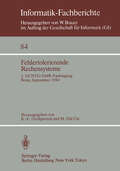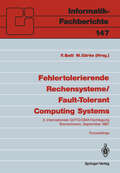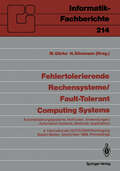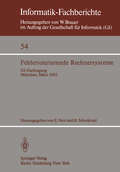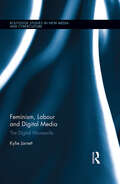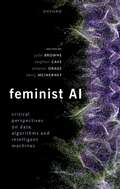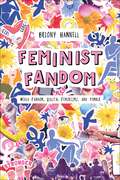- Table View
- List View
Fehlererkennung und Fehlerbehandlung in Speicherungsstrukturen von Datenbanksystemen (Informatik-Fachberichte #99)
by Klaus KüspertFehlerkorrigierende Codes: Konstruieren, Anwenden, Decodieren
by Olaf ManzDieses Buch stellt mit möglichst wenig mathematischen Hilfsmitteln die wesentlichen Grundbegriffe und Konzepte der Theorie fehlerkorrigierender Codes in der Datenübertragung dar. Alle historisch und für Praxisanwendungen wichtigen Klassen und Familien von Codes werden explizit konstruiert; dies beinhaltet auch deren Rate und Minimalabstand. Außerdem werden die wesentlichen Decodieralgorithmen beschrieben. Die Darstellung orientiert sich dabei an den zugehörigen "Meilensteinen" in der Geschichte der Codierungstheorie. Besonderer Wert gelegt wird außerdem auf die Vermittlung der Art und Weise, wie diese Codes in der Praxis angewandt werden. Das Buch eignet sich für Studierende im mathematisch-technischen Bereich an Fachhochschulen und Universitäten (z.B. in Proseminaren), auch für die MINT-Lehrerfortbildung und andere Weiterbildungsveranstaltungen für interessierte Anwender, Schüler und Senioren.
Fehlertolerante Anzeigengestaltung für Augmented Reality Head-up-Displays: Bewertung und Kompensation von Registrierungsfehlern im automobilen Kontext (AutoUni – Schriftenreihe #145)
by Vitalij SadovitchVitalij Sadovitch untersucht Auswirkungen von Registrierungsfehlern, die aufgrund technischer Limitationen bei einem Augmented Reality Head-up-Display auftreten können. Die Ergebnisse zeigen, dass derartige Fehler bei der Positionierung virtueller Anzeigeelemente die Systemakzeptanz der Nutzer maßgeblich beeinflussen. Des Weiteren werden fehlertolerante Gestaltungsmerkmale zur Kompensation von Registrierungsfehlern konzipiert und evaluiert. Die Erkenntnisse weisen darauf hin, dass eine fehlertolerante Anzeigengestaltung eine sinnvolle Ergänzung zu weiteren technischen Maßnahmen der Registrierungsoptimierung darstellt. Der Autor:Vitalij Sadovitch studierte Wirtschaftsinformatik und Human Factors. Anschließend hat er berufsbegleitend mit der vorliegenden Schrift an der TU Berlin promoviert und ist jetzt im Bereich der Entwicklung von Anzeige- und Bedienkonzepten für Augmented-Reality-Technologien in der technischen Entwicklung eines Automobilkonzerns tätig.
Fehlertolerante dezentrale Prozeßautomatisierung (Informatik-Fachberichte #160)
by Hubert MäncherIn der vorliegenden Monographie werden Verfahren zur Implementierung von Fehlertoleranz in dezentralen Automatisierungssystemen untersucht. Ausgehend von einer Analyse der angestrebten Ziele Zuverlässigkeit, Sicherheit und Wirtschaftlichkeit wird eine modifizierte Fehlertoleranz-Klassifizierung angegeben. Die exemplarische Realisierung eines fehlertoleranten Mikrorechnersystems basiert auf der globalen Grundstruktur dezentraler Automatisierungssysteme, in der durch die Zusammenfassung lokaler Subsysteme eine Rekonfiguration zur Tolerierung bestimmter Hardware-Fehler möglich wird. Dezentral realisierte Vergleichs- und Votiereinrichtungen erlauben auch die Tolerierung beliebiger Einfachfehler. Das zugehörige Echtzeitbetriebssystem ist mit der für Anwendungsprogramme transparenten Kommunikation in der Lage, alle Aufträge unabhängig vom Ort des Systemaufrufs und des Zielobjektes auszuführen. Zur Unterstützung des Betriebs von Echtzeitprogrammen werden Funktionszustände zur flexiblen Anpassung an äußere Abläufe behandelt. Anwenderprogramme in Form konfigurierbarer Software-Bausteine zeigen beispielartig die Realisierung fehlertoleranter Funktionen verschiedener Klassen, die gleichzeitig betrieben werden können. Ihre Erprobung an analog simulierten Testprozessen demonstriert die Anwendbarkeit der vorgestellten Konzepte.
Fehlertolerante Mikroprozessorsysteme (Forschungsberichte des Landes Nordrhein-Westfalen #3181)
by Walter GeisselhardtFehlertoleranz in verteilten Realzeitsystemen: Anwendungsorientierte Techniken (Informatik-Fachberichte #236)
by Jürgen J. StollIn diesem Buch werden Fehlertoleranztechniken in rekonfigurierbaren verteilten Systemen zur Prozeßautomatisierung in einer geschlossenen Form dargestellt. Neben grundlegenden Fragen zu verteilten Systemen und Prozeßrechensystemen, wodurch die Randbedingungen implizit festgelegt sind, werden die in der englischen Fachliteratur oft widersprüchlichen Begriffe aus dem Gebiet der Fehlertoleranztechnik systematisch geordnet und erläutert und ein konsistentes deutsches Basisbegriffsgebäude vorgestellt. Wissenschaftlich besonders reizvoll ist der Versuch, aus der Analyse biologischer Systeme Strukturprinzipien für redundante fehlertolerante technische Systeme abzuleiten. Das Hauptergebnis der Arbeit ist ein neuer Implementierungsvorschlag zur Spezifikation und Konstruktion vertrauenswürdiger Systeme: Es wird eine deskriptive Sprache inklusive der zugehörigen Datenstrukturen und deren Verkettung vorgestellt.
Fehlertoleranzverfahren (Studienreihe Informatik)
by Klaus EchtleDieses Buch beschreibt die grundlegenden Verfahren zur Tolerierung von Fehlern, die in Rechensystemen auftreten. Besondere Beachtung finden Fehlertoleranz-Maßnahmen für verteilte Systeme, da diese eine zunehmende Bedeutung erlangen. Die Ansätze zur Vermeidung von Zuverlässigkeitsengpässen durch Fehlertoleranz-Instanzen, die selbst fehlertolerant sind, werden ausführlich diskutiert. Die Darstellung ist weniger auf die Beschreibung existierender fehlertoleranter Rechensysteme ausgerichtet als vielmehr auf eine systematische, weitgehend implementierungsunabhängige Klassifikation der verschiedenen Schritte zur Fehlertoleranz und ihrer Varianten. Es wird ein Überblick gegeben, der die Entwurfsalternativen bei der Realisierung von Fehlertoleranz-Verfahren aufzeigt und ihre Auswirkungen auf Zuverlässigkeit, Leistungsfähigkeit und andere Eigenschaften eines Rechensystems verdeutlicht.
Fehlertolerierende Rechensysteme: 2. GI/NTG/GMR-Fachtagung / Fault-Tolerant Computing Systems 2nd GI/NTG/GMR Conference / Bonn, 19.–21. September 1984 (Informatik-Fachberichte #84)
by K. E. Grosspietsch M. Dal CinIn the last decade of Computer Science development, we can observe a growing interest in fault-tolerant computing. This interest is the result of a rising number of appl'ications where reliable operation of computing systems is an essential requirement. Besides basic research in the field of fault-tolerant computing, there is an increasing num ber of systems especially designed to achieve fault-tolerance. It is the objective of this conference to offer a survey of present research and development activities in these areas. The second GI/NTG/GM~ Conference on Fault-Tolerant Computing Systems has had a preparatory time of about two years. In March 1982, the first GI conference concerning fault-tolerant computing systems was held in Munich. One of the results of the conference was to bring an organiza tional framework to the FTC community in Germany. This led to the founding of the common interest group "Fault-Tolerant Computing Systems" of the Gesellschaft fur Informatik (GI), the Nachrichtentechnische Gesellschaft (NTG), and the Gesellschaft fur MeB- und Regelungstechnik (VDI/VDE-GMR) in November 1982. At that time, it was also decided to schedule a biannual conference on fault-tolerant computing systems. One of the goals of this second conference is to strengthen the relations with the international FTC community; thus, the call for papers was extended not only to German-speaking countries, but to other countries as well.
Fehlertolerierende Rechensysteme / Fault-Tolerant Computing Systems: 3. Internationale GI/ITG/GMA-Fachtagung / 3rd International GI/ITG/GMA Conference Bremerhaven, 9.–11. September 1987 (Informatik-Fachberichte #147)
by Fevzi Belli Winfried GörkeFehlertolerierende Rechensysteme / Fault-tolerant Computing Systems: Automatisierungssysteme, Methoden, Anwendungen / Automation Systems, Methods, Applications 4. Internationale GI/ITG/GMA-Fachtagung 4th International GI/ITG/GMA Conference Baden-Baden, 20.–22. September 1989, Proceedings (Informatik-Fachberichte #214)
by Winfried Görke Holger SörensenFehlertolerierende Rechnersysteme: GI-Fachtagung München, 11.–12. März 1982 Gemeinsam veranstaltet von GI-Fachausschuß 8 und Fachausschuß 11 und GMD-Institut für Rechner- und Programmstrukturen, Siemens AG (Informatik-Fachberichte #54)
by E. Nett Heinz SchwärtzelFeistel Ciphers: Security Proofs and Cryptanalysis
by Valerie Nachef Jacques Patarin Emmanuel VolteThis book provides a survey on different kinds of Feistel ciphers, with their definitions and mathematical/computational properties. Feistel ciphers are widely used in cryptography in order to obtain pseudorandom permutations and secret-key block ciphers. In Part 1, we describe Feistel ciphers and their variants. We also give a brief story of these ciphers and basic security results. In Part 2, we describe generic attacks on Feistel ciphers. In Part 3, we give results on DES and specific Feistel ciphers. Part 4 is devoted to improved security results. We also give results on indifferentiability and indistinguishability.
Feldbustechnik in Forschung, Entwicklung und Anwendung: Beiträge zur Feldbustagung FeT ’97 in Wien, Österreich, 13.–14. Oktober 1997
by Dietmar Dietrich Herbert SchweinzerFeldbussysteme sind im Zusammenwirken mit LANs (Large Area Network) und WANs (Wide Area Network) als Nervensystem anzusehen, das in Systeme aller Bereiche unseres Lebens eingebettet wird. Die Automatisierung erlebt dadurch zur Zeit eine revolutionäre Weiterentwicklung. Die Tagung FeT ’97 in Wien hat sich zum Ziel gesetzt, aktuelle Fragen zu diskutieren. Das Buch beinhaltet Aufsätze, die anläßlich dieser Tagung eingereicht und vom Programmkomitee bestbewertet wurden. Damit ist ein guter Überblick geboten, welche Schwerpunkte in der Feldbustechnik gegenwärtig bearbeitet werden. Der Aufbau des Buches erfolgt in zwei Teilen: der erste Teil beinhaltet Beiträge aus Forschung und Entwicklung, der zweite Teil Beiträge mit Produkt- und Anwendungsorientierung. Innerhalb dieser Teile gibt es eine Gliederung nach den Anwendungsschwerpunkten Industrietechnik, Gebäudeautomation und bereichsübergreifende Beiträge.
FEM Analysis of the Human Knee Joint: A Review (SpringerBriefs in Applied Sciences and Technology)
by Zahra Trad Abdelwahed Barkaoui Moez Chafra João Manuel TavaresIn recent years, numerous scientific investigations have studied the anatomical, biomechanical and functional role of structures involved in the human knee joint. The Finite Element Method (FEM) has been seen as an interesting tool to study and simulate biosystems. It has been extensively used to analyse the knee joint and various types of knee diseases and rehabilitation procedures such as the High Tibial Osteotomy (HTO). This work presents a review on FEM analysis of the human knee joint and HTO knee surgery, and discusses how adequate this computational tool is for this type of biomedical applications. Hence, various studies addressing the knee joint based on Finite Element Analysis (FEA) are reviewed, and an overview of clinical and biomechanical studies on the optimization of the correction angle of the postoperative knee surgery is provided.
FEM bei elektrischen Antrieben 1: Grundlagen, Vorgehensweise, Transformatoren und Gleichstrommaschinen
by Bernd AschendorfDie Auslegung und das Betriebsverhalten Elektrischer Antriebe wurde bislang in Lehrbü-chern anhand von Ersatzschaltbildern, Zeigerdiagrammen, Bildern und Diagrammen erläu-tert. Mit diesem Buch sollen Ergebnisse von Finite-Elemente-Rechnungen dazu dienen, das Betriebsverhalten Elektrischer Maschinen und deren Entwicklung und Auslegung zu verste-hen. Auf die Auswirkungen der Magnetisierungskurve von Eisen wird ebenso eingegangen wie auf den Einsatz von Zusatzwicklungen in Gleichstrommaschinen, die Auslegung von Drehstromwicklung, die Polgeometrie bei Synchronmaschinen und den Nutenaufbau bei Asynchronmaschinen. Auf einer beiliegenden DVD und weiterem ONLINE-Material sind zudem zahlreiche Darstellungen und Videos abgelegt.
Female Innovators at Work: Women on Top of Tech
by Danielle NewnhamThis book describes the experiences and successes of female innovators and entrepreneurs in the still largely male-dominated tech-world in twenty candid interviews. It highlights the varied life and career stories that lead these women to the top positions in the technology industry that they are in now.Interviewees include CEOs, founders, and inventors from a wide spectrum of tech organizations across sectors as varied as mobile technology, e-commerce, online education, and video games. Interviewer Danielle Newnham, a mobile startup and e-commerce entrepreneur herself as well as an online community organizer, presents the insights, instructive anecdotes, and advice shared with her in the interviews, including stories about raising capital for one’s start-up, and about the obstacles these women encountered and how they overcame them. This timely book will be of great interest to anyone working in tech or looking to get into the industry, and more in general: to everyone wanting to learn how they can contribute to leveling the field of occupational opportunity and to strengthening teams and companies through merit and diversity.
Female Offenders and Reentry: Pathways and Barriers to Returning to Society
by Lisa M. Carter Catherine D. MarcumOften, research concerning the female offender is scarce. This book adds to the criminological literature on the topic of reentry for women, focusing on the barriers women face as they return to society and adjust to life after incarceration. Each chapter addresses specific issues, challenges, and obstacles affiliated with the hindrance of successful reentry processes associated with female offenders, as well as data-driven empirical studies. While corrections has often misunderstood or overlooked the needs of returning offenders, the shortcomings of the institutions have a greater impact on women than on their male counterparts, particularly regarding the occurrence of social and medical problems, especially those related to mental health and substance abuse. Female Offenders and Reentry helps criminal justice students and practitioners see the full picture when considering the challenges faced by female offenders reintegrating into society.
Female Offenders and Reentry: Pathways and Barriers to Returning to Society
by Lisa M. Carter Catherine D. MarcumOften, research concerning the female offender is scarce. This book adds to the criminological literature on the topic of reentry for women, focusing on the barriers women face as they return to society and adjust to life after incarceration. Each chapter addresses specific issues, challenges, and obstacles affiliated with the hindrance of successful reentry processes associated with female offenders, as well as data-driven empirical studies. While corrections has often misunderstood or overlooked the needs of returning offenders, the shortcomings of the institutions have a greater impact on women than on their male counterparts, particularly regarding the occurrence of social and medical problems, especially those related to mental health and substance abuse. Female Offenders and Reentry helps criminal justice students and practitioners see the full picture when considering the challenges faced by female offenders reintegrating into society.
Feminism, Labour and Digital Media: The Digital Housewife (Routledge Studies in New Media and Cyberculture)
by Kylie JarrettThere is a contradiction at the heart of digital media. We use commercial platforms to express our identity, to build community and to engage politically. At the same time, our status updates, tweets, videos, photographs and music files are free content for these sites. We are also generating an almost endless supply of user data that can be mined, re-purposed and sold to advertisers. As users of the commercial web, we are socially and creatively engaged, but also labourers, exploited by the companies that provide our communication platforms. How do we reconcile these contradictions? Feminism, Labour and Digital Media argues for using the work of Marxist feminist theorists about the role of domestic work in capitalism to explore these competing dynamics of consumer labour. It uses the concept of the Digital Housewife to outline the relationship between the work we do online and the unpaid sphere of social reproduction. It demonstrates how feminist perspectives expand our critique of consumer labour in digital media. In doing so, the Digital Housewife returns feminist inquiry from the margins and places it at the heart of critical digital media analysis.
Feminism, Labour and Digital Media: The Digital Housewife (Routledge Studies in New Media and Cyberculture)
by Kylie JarrettThere is a contradiction at the heart of digital media. We use commercial platforms to express our identity, to build community and to engage politically. At the same time, our status updates, tweets, videos, photographs and music files are free content for these sites. We are also generating an almost endless supply of user data that can be mined, re-purposed and sold to advertisers. As users of the commercial web, we are socially and creatively engaged, but also labourers, exploited by the companies that provide our communication platforms. How do we reconcile these contradictions? Feminism, Labour and Digital Media argues for using the work of Marxist feminist theorists about the role of domestic work in capitalism to explore these competing dynamics of consumer labour. It uses the concept of the Digital Housewife to outline the relationship between the work we do online and the unpaid sphere of social reproduction. It demonstrates how feminist perspectives expand our critique of consumer labour in digital media. In doing so, the Digital Housewife returns feminist inquiry from the margins and places it at the heart of critical digital media analysis.
Feminist AI: Critical Perspectives on Algorithms, Data, and Intelligent Machines
by Jude Browne Stephen Cave Eleanor Drage Kerry McInerneyChapters 5, 12, and 18 of this work are available under the terms of a CC BY-NC-ND 4.0 International open access licence. These parts of the work are free to read on the Oxford Academic platform and offered as a free PDF download from OUP and selected open access locations. Feminist AI: Critical Perspectives on Algorithms, Data and Intelligent Machines is the first volume to bring together leading feminist thinkers from across the disciplines to explore the impact of artificial intelligence (AI) and related data-driven technologies on human society. Recent years have seen both an explosion in AI systems and a corresponding rise in important critical analyses of these technologies. Central to these analyses has been feminist scholarship, which calls upon the AI sector to be accountable for designing and deploying AI in ways that further, rather than undermine, the pursuit of social justice. This book aims to be a touchstone text for AI researchers concerned with the social impact of their systems, as well as theorists, students and educators in the field of gender and technology. It demonstrates the importance of an intersectional understanding of the risks and benefits of AI, approaching feminism as a political project that aims to challenge various interlocking forms of injustice, social inequality and structural relations of power. Feminist AI showcases the vital contributions of feminist scholarship to thinking about AI, data, and intelligent machines as well as laying the groundwork for future feminist scholarship on AI. It brings together scholars from a variety of disciplinary backgrounds, from computer science, software engineering, and medical sciences to political theory, anthropology, and literature. It provides an entry point for scholars of AI, science and technology into the diversity of feminist approaches to AI, and creates a rich dialogue between scholars and practitioners of AI to examine the powerful congruences and generative tensions between different feminist approaches to new and emerging technologies. It features original and essential works specially selected to span multiple generations of practitioners and scholars. These contributors are also attuned to conversations at industry-level around the risks and possibilities that frame the drive to adopt AI. This collection reflects the increasingly blurred divide between the academy, industry and corporate research groups and brings interdisciplinary feminist insights together with postcolonial studies, disability theory, and critical race studies to confront ageism, racism, sexism, ableism, and class-based oppressions in AI.
Feminist AI: Critical Perspectives on Algorithms, Data, and Intelligent Machines
by Jude Browne Stephen Cave Eleanor Drage Kerry McInerneyChapters 5, 12, and 18 of this work are available under the terms of a CC BY-NC-ND 4.0 International open access licence. These parts of the work are free to read on the Oxford Academic platform and offered as a free PDF download from OUP and selected open access locations. Feminist AI: Critical Perspectives on Algorithms, Data and Intelligent Machines is the first volume to bring together leading feminist thinkers from across the disciplines to explore the impact of artificial intelligence (AI) and related data-driven technologies on human society. Recent years have seen both an explosion in AI systems and a corresponding rise in important critical analyses of these technologies. Central to these analyses has been feminist scholarship, which calls upon the AI sector to be accountable for designing and deploying AI in ways that further, rather than undermine, the pursuit of social justice. This book aims to be a touchstone text for AI researchers concerned with the social impact of their systems, as well as theorists, students and educators in the field of gender and technology. It demonstrates the importance of an intersectional understanding of the risks and benefits of AI, approaching feminism as a political project that aims to challenge various interlocking forms of injustice, social inequality and structural relations of power. Feminist AI showcases the vital contributions of feminist scholarship to thinking about AI, data, and intelligent machines as well as laying the groundwork for future feminist scholarship on AI. It brings together scholars from a variety of disciplinary backgrounds, from computer science, software engineering, and medical sciences to political theory, anthropology, and literature. It provides an entry point for scholars of AI, science and technology into the diversity of feminist approaches to AI, and creates a rich dialogue between scholars and practitioners of AI to examine the powerful congruences and generative tensions between different feminist approaches to new and emerging technologies. It features original and essential works specially selected to span multiple generations of practitioners and scholars. These contributors are also attuned to conversations at industry-level around the risks and possibilities that frame the drive to adopt AI. This collection reflects the increasingly blurred divide between the academy, industry and corporate research groups and brings interdisciplinary feminist insights together with postcolonial studies, disability theory, and critical race studies to confront ageism, racism, sexism, ableism, and class-based oppressions in AI.
Feminist Fandom: Media Fandom, Digital Feminisms, and Tumblr
by Briony HannellExamines how fannish and feminist modes of cultural consumption, production, and critique are converging and opening up informal spaces for young people to engage with feminism. Adopting an interdisciplinary theoretical framework and bringing together media and communications, feminist cultural studies, sociology, internet studies and fan studies, Hannell locates media fandom at the intersection of the multi-directional and co-constitutive relationship between popular feminisms, popular culture and participatory networked digital cultures. Feminist Fandom functions as an ethnographic account of how feminist identities are constructed, lived and felt through digital fannish spaces on the micro-blogging and social networking platform, Tumblr.
Feminist Fandom: Media Fandom, Digital Feminisms, and Tumblr
by Briony HannellExamines how fannish and feminist modes of cultural consumption, production, and critique are converging and opening up informal spaces for young people to engage with feminism. Adopting an interdisciplinary theoretical framework and bringing together media and communications, feminist cultural studies, sociology, internet studies and fan studies, Hannell locates media fandom at the intersection of the multi-directional and co-constitutive relationship between popular feminisms, popular culture and participatory networked digital cultures. Feminist Fandom functions as an ethnographic account of how feminist identities are constructed, lived and felt through digital fannish spaces on the micro-blogging and social networking platform, Tumblr.








